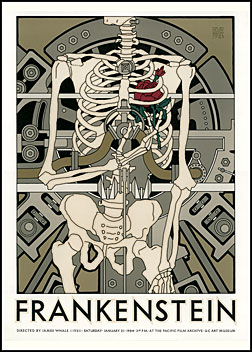
Click on image for detail
(#107) FRANKENSTEIN:
Edition of 2197 of which 300 are signed 1-300, 26 are signed A-Z as artist's proofs, and three sets are signed as progressives.
December 31, 1983 11 colors
17-1/8" x 24"
Influence: H. R. Giger
Client: The Pacific Film Archive (Tom Schmidt), University of California Art Museum, 2625 Durant Avenue, Berkeley CA 94720. Telephone (510) 642-1413
1-300: Saint Hieronymus Press, Inc.
A-Z: artist's own use.
Progressives: 1 set to the Pacific Film Archive, 2 sets to Saint Hieronymus Press, Inc.
In 1792 Mary Wolstoncraft wrote A Vindication of the Rights of Woman, a proto-feminist treatise that reads like it was published yesterday afternoon. Its central thesis is that it is unjust to accuse women of being ignorant while denying them an education; that women are not naturally inferior to men, and that men and women should have equal educational opportunities; that women should be educated because they are early educators of the young; and finally, realizing that women can have no control over their lives if they do not have control over their bodies.
In 1797, she married the radical anarchist William Godwin. Godwin believed that it was impossible to be rationally persuaded and not act accordingly; that therefore men can live in harmony without law and institutions; and that mankind is ultimately perfectible. Mary died in childbirth in 1797, and her younger daughter, also Mary, became the second wife of Percy Bysshe Shelley. He'd taken up with her in 1814, and though they did not believe in marriage, nonetheless availed themselves of that sacrament after Percy's pregnant first wife, Harriet Westbrook, drowned herself in the Serpentine in 1816 at the age of 21.
That dismal, sunless summer, Mary, Percy, Lord Byron and Mary's stepsister Claire Clairmont, were sitting around one night with nothing much to do, and challenged each other to write a rattling good story, or to try and scare the pants off one another. Nineteen-year-old Mary responded by conjuring up the heart-wrenching tale of the scientist Frankenstein, who by means of Galvanism animates a soulless monster from grave-yard fragments.
Longing for sympathy and love, but repellent to all about him, the creature pleads for a mate, but is cruelly denied. In retribution, he destroys the promised bride of his creator, and crying "Am I to be thought the only criminal, when all human kind sinned against me?" flees into a howling waste.
The pitiful monster, of course, has no name, but is commonly called by that of his creator. For every one who is familiar with the poetry of Percy Bysshe Shelley, there are ten thousand who know the Gothic novel Frankenstein, or the Modern Prometheus, written by his teenage bride.
07 Aug 2021